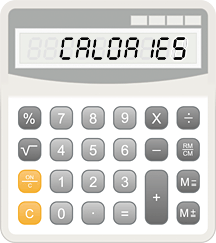Counting Calories
By Editorial Staff
Weight loss may seem complex, but it's really a matter of calories in versus calories out. Consume more calories than you expend, and you gain weight; reverse the equation and you lose weight. The greater the difference, the more or less weight you'll gain/lose. Let's take a closer look at calories and see why you need to be paying attention when you're eating your favorite foods.
The amount of food energy associated with a particular food and available for cellular respiration is represented in calories. Protein, carbohydrates, fats and fiber all account for this food energy, and we humans require a certain amount on a daily basis depending on our body type, activity levels and numerous other variables.
How many calories does the human body need? That number can vary considerably based on individual energy requirements. The established number for an "average" adult is around 2,000 for women and 2,500 for men; however, your energy needs will be greater or less - perhaps substantially so - depending on how well your body utilizes energy (metabolism) and how much it expends during the course of daily activities. For example, as might be expected, your body will burn thousands of calories during a marathon, whereas at rest (sitting on a couch watching TV), few calories will be burned and likely replaced (and then some) with all-too-common "couch" foods such as potato chips and soft drinks.
Similar Portions Can Have Big Calorie Differences
The type of food can make a big difference in terms of the number of calories. Keep in mind that a fat gram contains 9 calories, whereas a protein or carbohydrate gram contains only 4 calories. Now are you beginning to see why the food you eat can have a major impact on your overall caloric intake, regardless of portion size?
 Consider 2 cups of cooked broccoli, which has only about 60 total calories, versus 2 cups of plain brown rice. Even though the rice dish has little or no fat, just like the broccoli dish, the rice has substantially more calories (about 400) because it is of substantially different composition: 45 grams of carbohydrate per cup (at 4 calories each) compared to only about 6 grams of carbohydrates per cup of broccoli (also at 4 calories each). Both fats have minimal fat and protein; it's the carbs that make a big difference here.
Consider 2 cups of cooked broccoli, which has only about 60 total calories, versus 2 cups of plain brown rice. Even though the rice dish has little or no fat, just like the broccoli dish, the rice has substantially more calories (about 400) because it is of substantially different composition: 45 grams of carbohydrate per cup (at 4 calories each) compared to only about 6 grams of carbohydrates per cup of broccoli (also at 4 calories each). Both fats have minimal fat and protein; it's the carbs that make a big difference here.
Now consider a plate of cheese-covered nachos, covering the same basic area on a plate as would the broccoli or rice, yet with high-fat ground beef and cheese accounting for approximately 60 grams of fat. Remember that each fat gram counts as 9 calories, so your mouth-watering nacho plate is already weighing in at a whopping 540 calories, and that's just considering the fat calories! Add in the carbohydrates and fat from the tortilla chips and the protein from the cheese and ground beef, and your "snack" could be exceeding 800 calories; more than a third of your daily intake.
These are rough estimates and don't represent the entire picture when it comes to calories or weight loss (remember, fat, protein and carbohydrates are all used differently by the body), but the point is, calories count. That doesn't mean you need to hyperanalyze every food and keep a daily log down to the last calorie (although for some people, that may work); however, it is about recognizing foods that are low calorie versus foods that are substantially higher calorie, so you can make informed decisions when you eat.
Consider the broccoli example. Many people eat broccoli, but often top it with a generous portion of cheese. An average slice of regular (not reduced fat) cheese contains 9 grams of fat. Melt a few slices on top of your cup of broccoli, and you've added 162 calories to your "healthy" side dish! Another great example is salad dressing. Whip up a healthy, fat-free, low-calorie salad of greens, tomatoes, carrots and other tasty vegetables; but then top it with 3-4 tablespoons of your favorite dressing, which averages 13-14 grams of fat per tablespoon (again, if not the reduced-fat variety). Sure, you're getting the health benefits of all those vegetables, but you've added somewhere in the neighborhood of 468 extra calories (13 fat grams x 4 tablespoons x 9 calories per fat gram)! And don't forget that you're filling up on fat, which is never good for weight loss.
Healthy 100-Calorie Foods
Now let's consider some easy-to-prepare snacks that pack only about 100 calories per punch (courtesy of WebMD). Consume these low-cal foods regularly and you'll fill up on good nutrition, not high calories:
- 1/2 medium apple, 2 tsp of peanut butter
- 10 almonds, cashew nuts, etc.
- 4-6 ounces of non-fat yogurt
- Half a string cheese, 3-4 whole-wheat crackers
- 1 slice whole-wheat toast with 1/4 cup applesauce
(Note: calorie counts may vary depending on the brand of bread, peanut butter, string cheese, etc; always check food labels to see how many calories you're actually getting.

